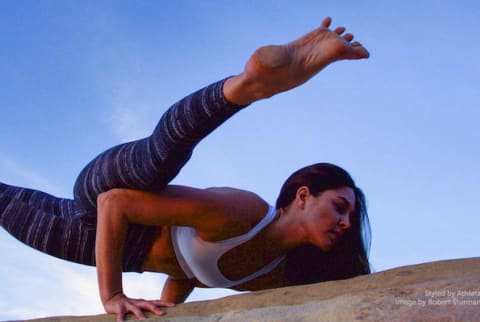Advertisement
How To "Kick" Your Yoga Practice Up A Notch

If your Sun Salutations are starting to feel a bit stale, it might be time switch up your yoga practice. While it may sound unconventional and even contradictory, consider looking for inspiration off your mat and into a dojo — a martial arts training facility — instead.
Yoga and martial arts may seem diametrically opposed, but these two ancient art forms share much in common. Both cultivate body awareness, strength, flexibility, breath control, discipline, humility and focus. Apply these martial arts principles to your yoga practice to help kick it up a notch.
1. Be like water.
Bruce Lee was onto something when he famously made that statement, but he was merely echoing the teachings of Lao-Tzu and the Tao Te Ching, which says, "Nothing in the world is as soft and yielding as water. Yet for dissolving the hard and inflexible, northing can surpass it."
The art of yielding is a founding principle of many martial arts styles. The idea is to use your opponent's energy against them, thereby using as little force as possible to achieve a maximum result. In your yoga practice, be like water and soften into poses rather than fighting against your own body. Use your breath to go deeper and allow the pose to unfold in its own time.
Add fluid movement to traditionally static postures to bring a more oceanic quality to your practice. In Crescent Lunge Pose (Anjaneyasana) reach your arms to the sky on an inhalation, then allow the arms to flow back like wings as you lean your torso forward on the exhalation. On the next inhalation, lift the torso and send your arms back to the sky. Repeat this fluid motion for 3-5 cycles of breath. Follow the path of least resistance to get more out of your practice.
2. Practice blindfolded.
Many martial arts styles incorporate blindfolded drills into their training to help improve proprioceptive awareness and muscle memory. Practicing yoga blindfolded requires us to be fully present in our physical bodies, allowing us to get out of our minds. It enhances balance, coordination and improves tactile senses.
Stand blindfolded in Mountain Pose (Tadasana) and bring awareness to your foundation. Gently rock forward into your toes and back into your heels and observe how the blindfold challenges your sense of balance. Once you feel comfortable in Mountain Pose, begin to flow through a few rounds of gentle Sun Salutations. Start slowly and gradually build up to more challenging poses, longer sequences, and eventually a full practice guided solely by sensation over sight.
3. Get out of your comfort zone.
Martial artists are constantly pushing past their comfort zone every time they step up to face a new opponent. Apply this to your yoga practice by trying out a new style. While there is value in repetition and consistency, training your body in only one way will only make you stronger in one way.
Adding variety to your practice will challenge both your habitual patterns of movement and your mental attitudes. Explore a new studio, try out a new teacher, or completely switch up your style. Create new connections by going to AcroYoga with a partner, or consider taking your practice global on a yoga retreat.
Moving out of your comfort zone can also mean finding the strength and confidence to work towards a pose that scares you, such as an arm balance or inversion. Break down the components of the challenge pose and don’t be afraid to reach for a little support in the form of props or a friend to spot you.
4. Make every move count.
In martial arts, every move becomes the difference between winning and losing. While yoga is not a competition, there is value in making every movement count. Many people are so intent on locking into a specific posture that they forget about the journey getting there. Focus on the transitions. Make how you move into and out of a pose just as important as the pose itself.
Visualize your practice not as individual poses, but instead as a slow and thoughtful dance. When the next pose is called, do not think of it as the end goal. Synchronize your inhale and exhale to each new movement along the way, and allow one pose to merge seamlessly into the next — think of the gracefulness of Tai Chi. Stay present and use the transition as an opportunity to explore your practice.
5. Meditate.
'Kicking' it up doesn't always mean kicking butt. As it says in the Tao Te Ching, "Less and less do you need to force things, until you finally arrive at non-action. When nothing is done, nothing is left undone." Practice the art of non-doing and your yoga practice will exponentially expand.
Carve out five minutes after your practice to sit in stillness with your eyes closed. Use this simple concentration practice to help focus your mind and relax your body.
Inhale fully, allowing your belly to expand, then exhale the breath out slowly. At the bottom of your exhalation, mentally count, “One.” Take another full cycle of breath and mentally count, “Two” at the bottom of the exhalation. Continue the count all the way up to 10, counting only on the exhalations. If you lose your count, simply start back at one. Don’t be discouraged if you only make it to three or four before your mind wanders. The practice is simply observing when your mind has wandered and gently guiding yourself back.
Photo courtesy of the author
